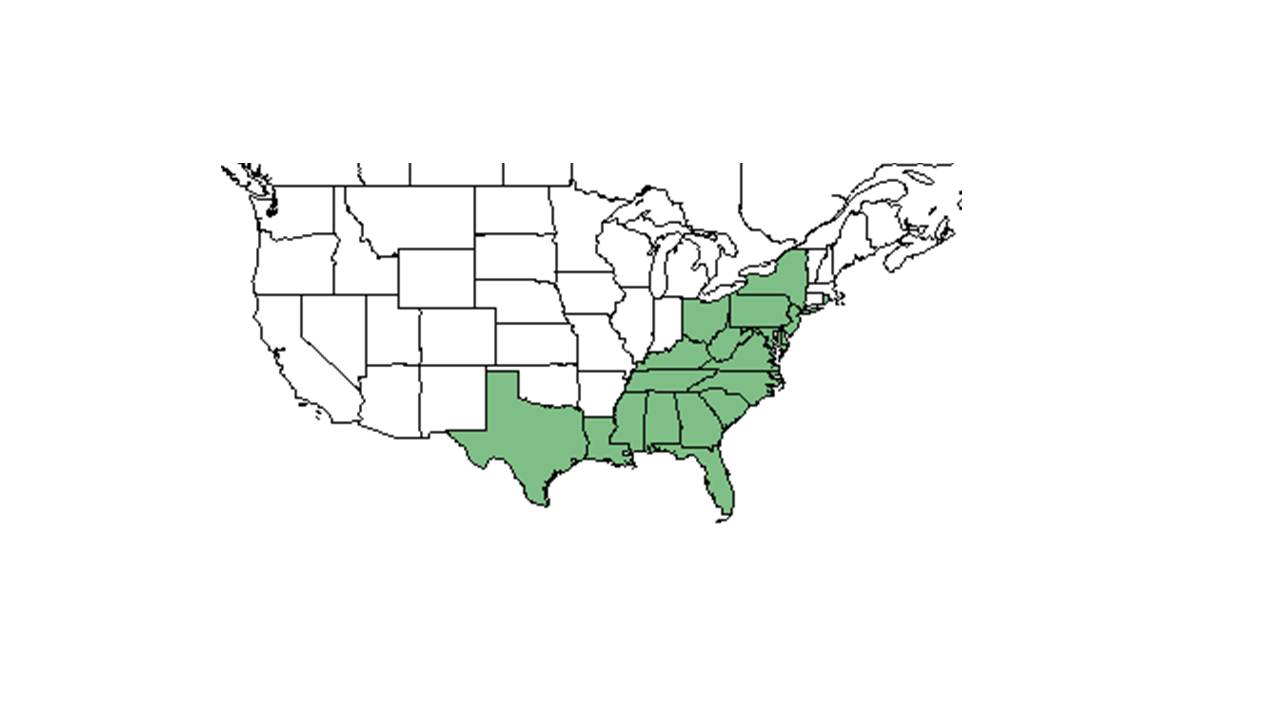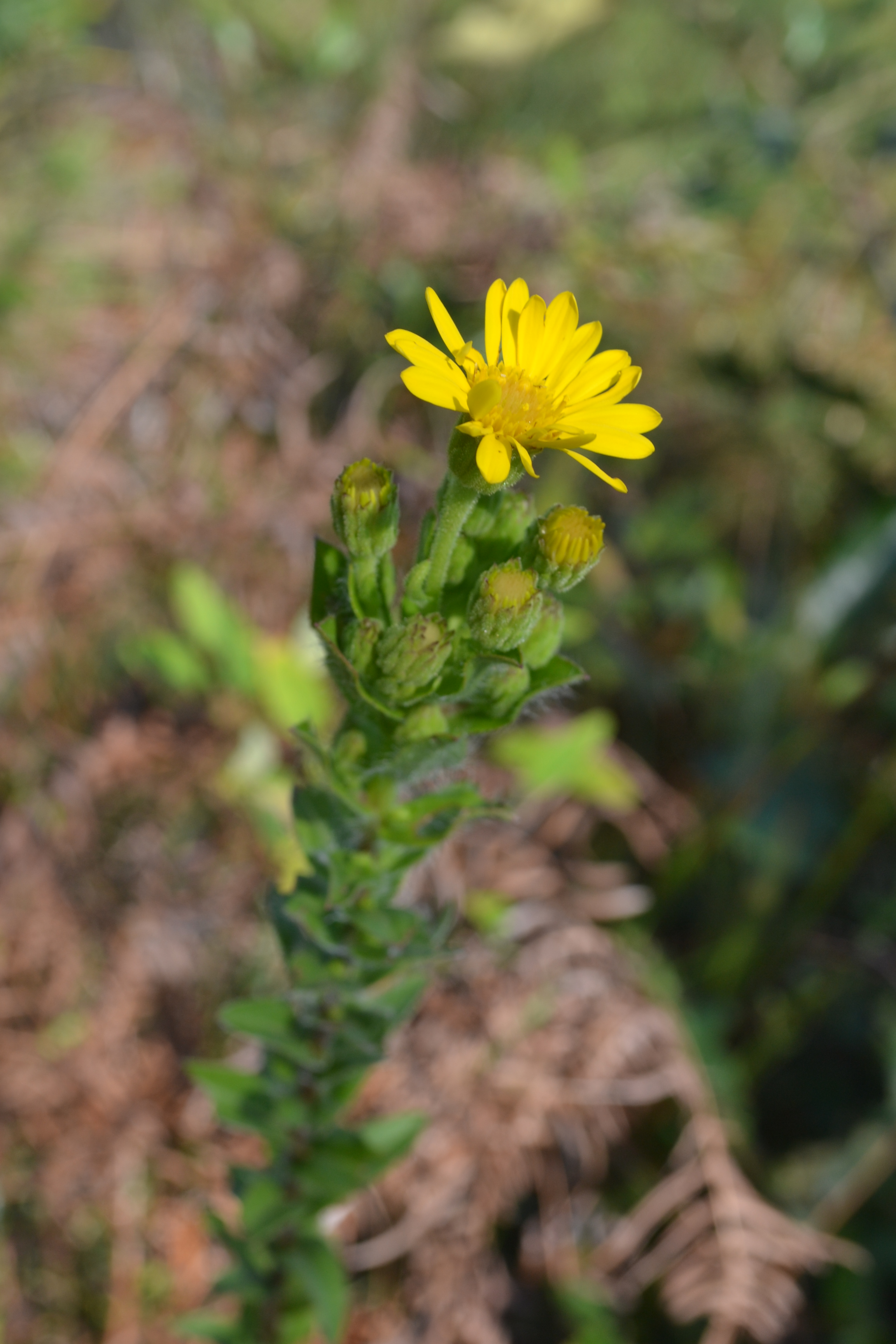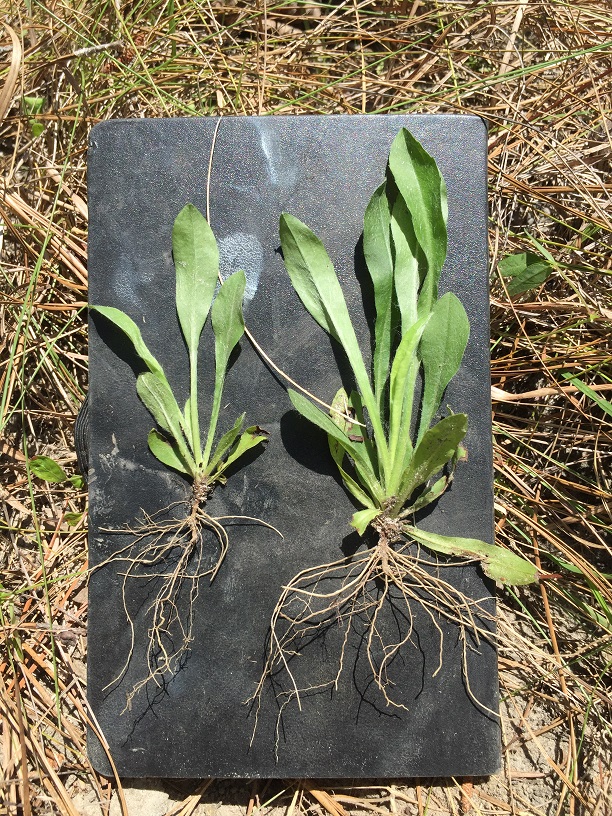Chrysopsis mariana
| Chrysopsis mariana | |
|---|---|

| |
| photo by Gil Nelson | |
| Scientific classification | |
| Kingdom: | Plantae |
| Division: | Magnoliophyta - Flowering plants |
| Class: | Magnoliopsida – Dicotyledons |
| Order: | Asterales |
| Family: | Asteraceae ⁄ Compositae |
| Genus: | Chrysopsis |
| Species: | C. mariana |
| Binomial name | |
| Chrysopsis mariana (L.) Elliott | |

| |
| Natural range of Chrysopsis mariana from USDA NRCS Plants Database. | |
Common name: Maryland Golden-aster
Contents
Taxonomic notes
Synonyms: Heterotheca mariana (Linnaeus) Shinners[1]
Varieties: Chrysopsis mariana var. macradenia Fernald[1]
Description
A description of Chrysopsis mariana is provided in The Flora of North America. Remains in a low and sturdy rosette until it flowers in the late summer with clusters of yellow aster-like flowers. Foliage is woolly when young, and becomes smoother as it ages.[2]
Distribution
C. mariana is native to the eastern and southeastern United States, ranging from New York and Ohio south to Florida and as far west as Louisiana and Texas.[3] Populations of differing ploidy are distributed in different areas; diploids can be found in the Florida panhandle and central peninsula, tetraploids can be found in northeast Florida and the north peninsula, hexaploids can be found over the rest of the native distribution besides Florida except for the north central panhandle, and octoploids can be found along the northeast coastline of Florida either near or on Merritts Island.[4]
Ecology
Habitat
C. mariana can live in humid and mild climates with plenty of rainfall throughout the year. It can tolerate temperatures ranging from 3 to 33 degrees Celsius. It is found in abundance in longleaf pine communities and also has grown in sand ridges and live oak floodplain forests.[5][6] Chrysopsis mariana is restricted to native groundcover with a statistical affinity in upland pinelands of South Georgia.[7] It has been observed to grow in open and shaded environments in moist loamy sands. It's been found in disturbed areas such as sandy clearings within pine-hardwood forests, clear cut pine plantations, and along dirt roads.[6] It is listed as an obligate upland species, and almost never occurs in wetlands.[3]
C. mariana was found to decrease occurrence in response to soil disturbance by agriculture in southwest Georgia. It has also shown resistance to regrowth in reestablished savannas that were disturbed by agriculture.[8][9] C. mariana became absent in response to military training disturbance in west Georgia. It additionally showed resistance to regrowth in reestablished longleaf pine forests that were disturbed by military training.[10] However, it was found to be neutral in its short-term response to single mechanical soil disturbances, but was a decreaser in its long-term response following cessation of repeated soil disturbance.[11]
Chrysopsis mariana is frequent and abundant in the Clayhill Longleaf Woodlands community type and is considered an indicator species for the Panhandle Silty Longleaf Woodlands community type as described in Carr et al. (2010),[12] and is a potential indicator of longleaf pine savanna native ground-cover.[13][9] Additionally, a study exploring longleaf pine patch dynamics found C. mariana to be most strongly represented within longleaf pine gaps and under patches of longleaf that are up to 50 years of age.[14]
Associated species include longleaf pine, turkey oak, and live oak.[6]
Phenology
C. mariana flowers in the fall.[15]It has also been observed in north Florida to flower January to March, May, July, October, and November.[16] It fruits in May and November.[6]
Seed dispersal
This species is thought to be dispersed by wind. [17]
Fire ecology
Populations of Chrysopsis mariana have been known to persist through repeated annual burns.[18] C. mariana tends to appear in large numbers after a site is burned.[6] One study found it to be a major species in frequency following burns, and was the greatest biomass after a spring burn, rather than a winter or summer burn. However, overall frequency of the species was not affected by seasonality of fire.[5]
Pollination
Chrysopsis mariana has been observed to host ground-nesting bees from the Andrenidae family such as Andrena fulvipennis and Perdita boltoniae, as well as leafcutting bees such as Coelioxys sayi (family Megachilidae), and bees from the family Apidae such as Triepeolus atripes and T. pectoralis.[19]
Herbivory and toxicology
C. mariana hosts aphids such as Uroleucon sp. (family Aphididae). C. mariana consists of about 2-5% of the diet of large mammals.[20]
Conservation, cultivation, and restoration
C. mariana should avoid soil disturbance by agriculture and military training to conserve its presence in pine communities.[8][9][10]It is listed as endangered by the Pennsylvania Department of Conservation and Natural Resources, and is listed as threatened by the Rhode Island Department of Environmental Management.[3]
Cultural use
Photo Gallery
References and notes
- ↑ 1.0 1.1 Weakley, A.S. 2020. Flora of the Southeastern United States. Edition of 20 October 2020. University of North Carolina at Chapel Hill, Chapel Hill, North Carolina.
- ↑ [[1]] Lady Bird Johnson Wildflower Center. Accessed: April 5, 2019
- ↑ 3.0 3.1 3.2 USDA, NRCS. (2016). The PLANTS Database (http://plants.usda.gov, 5 April 2019). National Plant Data Team, Greensboro, NC 27401-4901 USA.
- ↑ Weakley, A. S. (2015). Flora of the Southern and Mid-Atlantic States. Chapel Hill, NC, University of North Carolina Herbarium.
- ↑ 5.0 5.1 Kush, J. S., et al. (2000). Understory plant community response to season of burn in natural longleaf pine forests. Proceedings 21st Tall Timbers Fire Ecology Conference. Fire and forest ecology: innovative silviculture & vegetation management, Tallahassee, FL, Tall Timbers Research, Inc.
- ↑ 6.0 6.1 6.2 6.3 6.4 Florida State University Robert K. Godfrey Herbarium database. URL: http://herbarium.bio.fsu.edu. Last accessed: June 2014. Collectors: Loran C. Anderson, Wilson Baker, Bill Boothe, Kathleen Craddock Burks, R.K. Godfrey, Ann F. Johnson, R. Komarek, R L Lazor, John Morrill, R. A. Norris, Ginny Vail, and Jean W. Wooten. States and Counties: Florida: Calhoun, Franklin , Gulf , Jackson, Jefferson, Leon, Liberty, Taylor, Union, and Wakulla. Georgia: Thomas.
- ↑ Ostertag, T.E., and K.M. Robertson. 2007. A comparison of native versus old-field vegetation in upland pinelands managed with frequent fire, South Georgia, USA. Pages 109–120 in R.E. Masters and K.E.M. Galley (eds.). Proceedings of the 23rd Tall Timbers Fire Ecology Conference: Fire in Grassland and Shrubland Ecosystems.
- ↑ 8.0 8.1 Kirkman, L.K., K.L. Coffey, R.J. Mitchell, and E.B. Moser. Ground Cover Recovery Patterns and Life-History Traits: Implications for Restoration Obstacles and Opportunities in a Species-Rich Savanna. (2004). Journal of Ecology 92(3):409-421.
- ↑ 9.0 9.1 9.2 Ostertag, T. E. and K. M. Robertson (2007). A comparison of native versus old-field vegetation in upland pinelands managed with frequent fire, south Georgia, USA. Proceedings of the 23rd Tall Timbers Fire Ecology Conference: Fire in Grassland and Shrubland Ecosystems, Tallahassee, Tall Timbers Research Station.
- ↑ 10.0 10.1 Dale, V.H., S.C. Beyeler, and B. Jackson. (2002). Understory vegetation indicators of anthropogenic disturbance in longleaf pine forests at Fort Benning, Georgia, USA. Ecological Indicators 1(3):155-170.
- ↑ Dixon, C. M., K. M. Robertson, A. M. Reid and M. T. Rother. 2024. Mechanical soil disturbance in a pine savanna has multiyear effects on plant species composition. Ecosphere 15(2):e4759.
- ↑ Carr, S.C., K.M. Robertson, and R.K. Peet. 2010. A vegetation classification of fire-dependent pinelands of Florida. Castanea 75:153-189.
- ↑ Carr, S. C., et al. (2010). "A Vegetation Classification of Fire-Dependent Pinelands of Florida." Castanea 75(2): 153-189.
- ↑ Mugnani et al. (2019). “Longleaf Pine Patch Dynamics Influence Ground-Layer Vegetation in Old-Growth Pine Savanna”.
- ↑ Kirkman, L. K., K. L. Coffey, et al. (2004). "Ground cover recovery patterns and life-history traits: implications for restoration obstacles and opportunities in a species-rich savanna." Journal of Ecology 92(3): 409-421.
- ↑ Nelson, G. PanFlora: Plant data for the eastern United States with emphasis on the Southeastern Coastal Plains, Florida, and the Florida Panhandle. www.gilnelson.com/PanFlora/ Accessed: 7 DEC 2016
- ↑ Kirkman, L. Katherine. Unpublished database of seed dispersal mode of plants found in Coastal Plain longleaf pine-grasslands of the Jones Ecological Research Center, Georgia.
- ↑ Robertson, K.M. Unpublished data collected from Pebble Hill Fire Plots, Pebble Hill Plantation, Thomasville, Georgia.
- ↑ Discoverlife.org [2]
- ↑ Miller, J.H., and K.V. Miller. 1999. Forest plants of the southeast and their wildlife uses. Southern Weed Science Society.

